
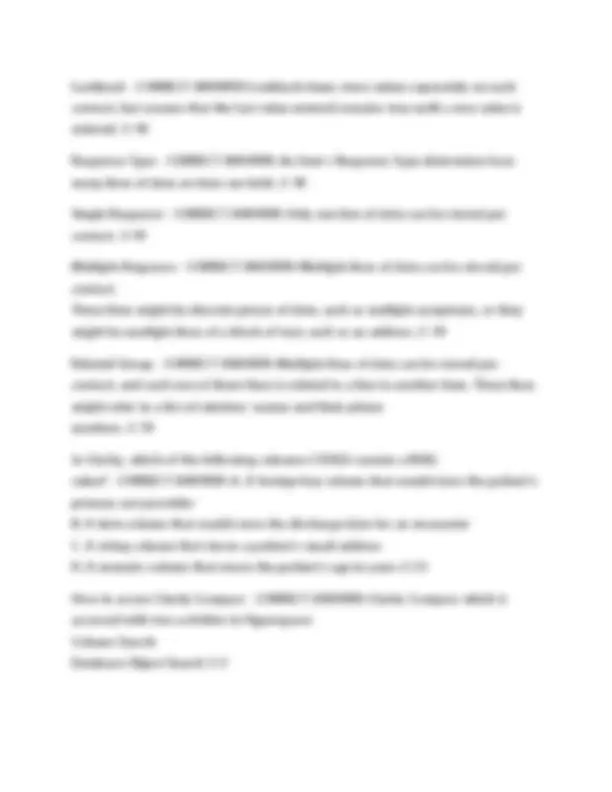
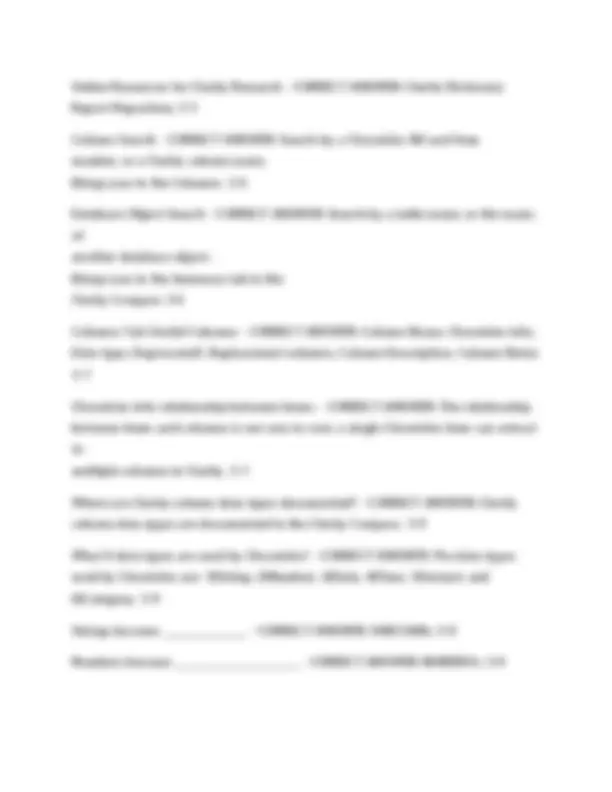
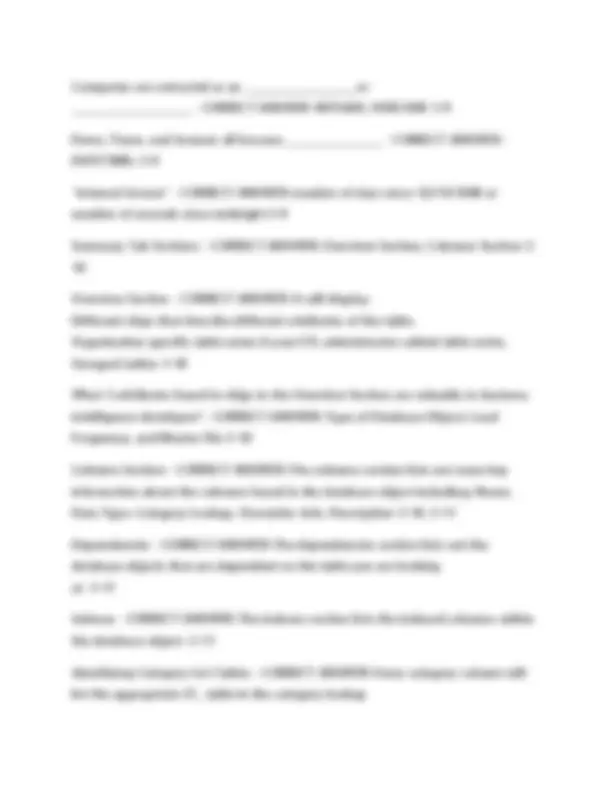
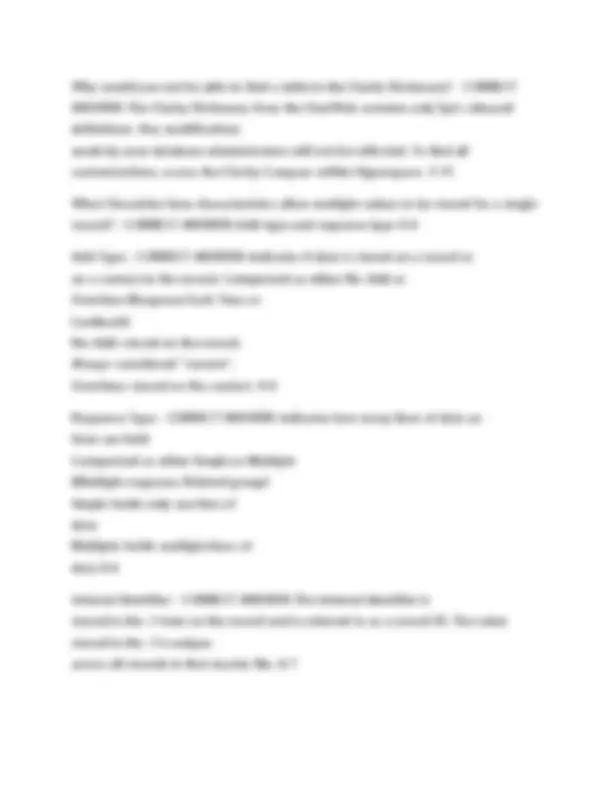
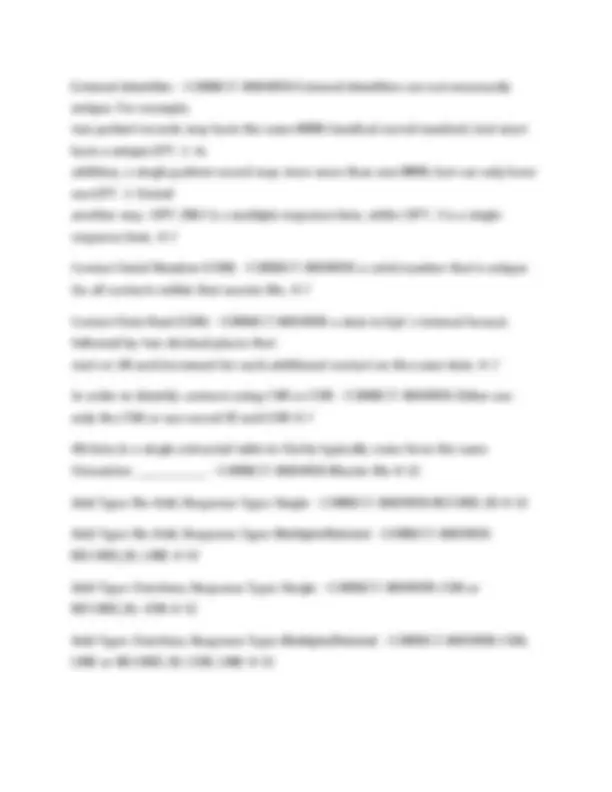
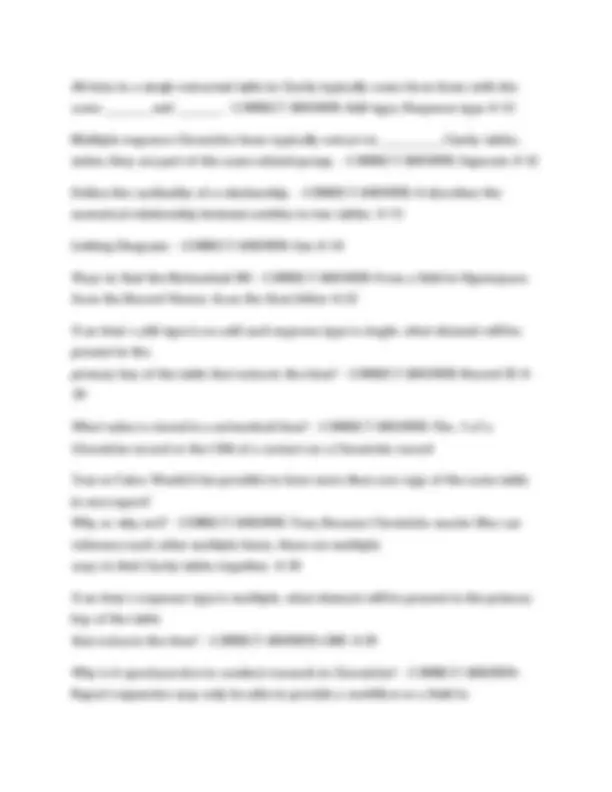
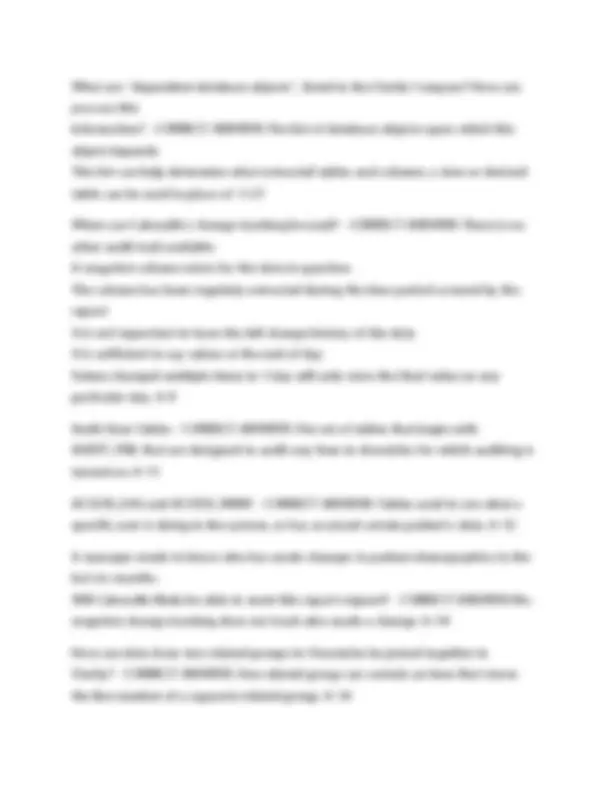



Study with the several resources on Docsity

Earn points by helping other students or get them with a premium plan


Prepare for your exams
Study with the several resources on Docsity

Earn points to download
Earn points by helping other students or get them with a premium plan
Community
Ask the community for help and clear up your study doubts
Discover the best universities in your country according to Docsity users
Free resources
Download our free guides on studying techniques, anxiety management strategies, and thesis advice from Docsity tutors
Steps when receiving a Clarity Request - **CORRECT ANSWER-0. Identify the data elements you will need for the report. 1. Find the INI + Item numbers of the data points to use on the report. 2. Use the INI + Item numbers to find the appropriate Clarity tables and columns. 3. Join the Clarity tables together using the correct foreign key information. 2-4**
Typology: Exams
1 / 14

This page cannot be seen from the preview
Don't miss anything!









Steps when receiving a Clarity Request - **CORRECT ANSWER-0. Identify the data elements you will need for the report.
items that store the value you searched for. 2- 10 Null Values in Clarity - CORRECT ANSWER-Any Clarity columns that is not a primary key can contain null values. Even foreign keys may be null. Null values exist for several reasons: Not all fields are populated in Chronicles ETL data cleansing deletes incorrectly formatted data A column may no longer extract data because it is deprecated. 2- 11 Item Editor - CORRECT ANSWER-The Item Editor shows the definitions of a Chronicles item. 2- 11 Category List - CORRECT ANSWER-When using a category list value as a filter, the query can run more efficiently when filtering on the category value itself rather than the name in the category list table. To find name to display for a particular value, you need to see the category list. 2- 12 Add Type - CORRECT ANSWER-An item's Add Type describes how long a piece of data is valid. It determines whether an item's value is stored on each contact, or directly to the record. 2- 17 No-Add - CORRECT ANSWER- No‐Add items store data directly on a record, not a specific contact. The value of a no‐add item should be considered true for all contacts on that record. 2- 18 Response Each Time - CORRECT ANSWER-Response each time items store values separately on each of a record's contacts. If a response each time item is blank for a certain contact, it should be considered unknown. 2- 18
Online Resources for Clarity Research - CORRECT ANSWER-Clarity Dictionary Report Repository 3- 5 Column Search - CORRECT ANSWER-Search by a Chronicles INI and Item number, or a Clarity column name. Brings you to the Columns. 3- 6 Database Object Search - CORRECT ANSWER-Search by a table name, or the name of another database object. Brings you to the Summary tab in the Clarity Compass 3- 6 Columns Tab-Useful Columns - CORRECT ANSWER-Column Name, Chronicles info, Data type, Deprecated?, Replacement columns, Column Description, Column Notes 3 - 7 Chronicles Info relationship between items: - CORRECT ANSWER-The relationship between items and columns is not one‐to‐one: a single Chronicles item can extract to multiple columns in Clarity. 3- 7 Where are Clarity column data types documented? - CORRECT ANSWER-Clarity column data types are documented in the Clarity Compass. 3- 9 What 6 data types are used by Chronicles? - CORRECT ANSWER-The data types used by Chronicles are: 1)String, 2)Number, 3)Date, 4)Time, 5)Instant, and 6)Category. 3- 9 Strings become _________________ - CORRECT ANSWER-VARCHARs 3- 9 Numbers become _________________________ - CORRECT ANSWER-NUMERICs 3- 9
Categories are extracted as an ______________________ or ________________________ - CORRECT ANSWER-INTEGER, VARCHAR 3- 9 Dates, Times, and Instants all become ___________________ - CORRECT ANSWER- DATETIMEs 3- 9 "internal format" - CORRECT ANSWER-number of days since 12/31/1840 or number of seconds since midnight 3- 9 Summary Tab Sections - CORRECT ANSWER-Overview Section, Columns Section 3- 10 Overview Section - CORRECT ANSWER-It will display: Different chips that describe different attributes of the table, Organization specific table notes if your ETL administrator added table notes, Grouped tables 3- 10 What 3 attributes found in chips in the Overview Section are valuable to business intelligence developer? - CORRECT ANSWER-Type of Database Object, Load Frequency, and Master File 3- 10 Columns Section - CORRECT ANSWER-The columns section lists out some key information about the columns found in the database object including: Name, Data Type, Category Lookup, Chronicles Info, Description 3-10, 3- 11 Dependencies - CORRECT ANSWER-The dependencies section lists out the database objects that are dependent on the table you are looking at. 3- 11 Indexes - CORRECT ANSWER-The indexes section lists the indexed columns within the database object. 3- 11 Identifying Category List Tables - CORRECT ANSWER-Every category column will list the appropriate ZC_ table in the category lookup
Clarity Console - CORRECT ANSWER-Schedules the extract of defined tables from Chronicles into Clarity. Displays information about previously run extracts. 3- 17 Incremental Load Frequency - CORRECT ANSWER-Takes place nightly. This load frequency is used for most Clarity tables. 3- 17 Deprecation - CORRECT ANSWER-Epic doesn't delete columns or tables once released. However, there are times when an Epic data structure changes so radically that it's no longer possible to populate old tables with it. In these cases, the table or column will be deprecated. 3- 19 Clarity Compass - CORRECT ANSWER-The Clarity Compass stores a list of all possible database objects that can be extracted to the Clarity database. 3- 21 Cogito Dictionary - CORRECT ANSWER-The Cogito Dictionary lives in the Analytics Catalog. 3- 23 How can you specifically search the Analytics Catalog for only Clarity database objects? - CORRECT ANSWER-By putting CL in front of your search item 3- 24 True or False: The Clarity Console stores definitions for the database objects that can be extracted to and stored in the Clarity database. - CORRECT ANSWER-False. The Clarity Compass stores these definitions. 3- 31 Which tool would you use to find the table and column that extracts EPT 18864: Attending Provider? - CORRECT ANSWER-Column Search, to enter the Clarity Compass 3- 31 What happens when a column is marked as Deprecated? - CORRECT ANSWER-No more data will be extracted into the column. 3- 31
Why would you not be able to find a table in the Clarity Dictionary? - CORRECT ANSWER- The Clarity Dictionary from the UserWeb contains only Epic‐released definitions. Any modifications made by your database administrators will not be reflected. To find all customizations, access the Clarity Compass within Hyperspace. 3- 31 What Chronicles item characteristics allow multiple values to be stored for a single record? - CORRECT ANSWER-Add type and response type 4- 6 Add Type - CORRECT ANSWER-Indicates if data is stored on a record or on a contact in the record. Categorized as either No‐Add or Overtime ﴾ Response Each Time or Lookback ﴿ No‐Add: stored on the record. Always considered "current". Overtime: stored on the contact. 4- 6 Response Type - CORRECT ANSWER-Indicates how many lines of data an item can hold Categorized as either Single or Multiple ﴾ Multiple response, Related group ﴿ Single: holds only one line of data Multiple: holds multiple lines of data 4- 6 Internal Identifier - CORRECT ANSWER-The internal identifier is stored in the .1 item on the record and is referred to as a record ID. The value stored in the .1 is unique across all records in that master file. 4- 7
All data in a single extracted table in Clarity typically come from items with the same _________ and _________ - CORRECT ANSWER-Add type, Response type 4- 12 Multiple response Chronicles items typically extract to ____________ Clarity tables, unless they are part of the same related group. - CORRECT ANSWER-Separate 4- 12 Define the cardinality of a relationship. - CORRECT ANSWER-It describes the numerical relationship between entities in two tables. 4- 13 Linking Diagrams - CORRECT ANSWER-See 4- 14 Ways to find the Networked INI - CORRECT ANSWER-From a field in Hyperspace, from the Record Viewer, from the Item Editor 4- 22 If an item's add type is no add and response type is single, what element will be present in the primary key of the table that extracts the item? - CORRECT ANSWER-Record ID 4- 39 What value is stored in a networked item? - CORRECT ANSWER-The .1 of a Chronicles record or the CSN of a contact on a Chronicles record True or False: Would it be possible to have more than one copy of the same table in one report? Why or why not? - CORRECT ANSWER-True; Because Chronicles master files can reference each other multiple times, there are multiple ways to link Clarity tables together. 4- 39 If an item's response type is multiple, what element will be present in the primary key of the table that extracts the item? - CORRECT ANSWER-LINE 4- 39 Why is it good practice to conduct research in Chronicles? - CORRECT ANSWER- Report requesters may only be able to provide a workflow or a field in
Hyperspace. In Chronicles you can open the Record Viewer and validate the data in the source and explore links between the data points. The most reliable way to find the Clarity column that reflects the data point is to use the information stored in the Clarity Compass. Understanding how the data is structured in Chronicles will allow you to better understand the structure of Clarity. 4- 39 What is the most common database object in Clarity? - CORRECT ANSWER- Extracted tables 5- 5 ER Diagrams - CORRECT ANSWER-An ER diagram is a visual tool that shows relationships between database objects relevant to a particular reporting area. ER Diagrams can help you to discover whether or not there is a view or derived table. 5- 5 ER Diagrams contain: - CORRECT ANSWER-Common tables and their links for a particular reporting area, and relationship cardinality of frequent joins 5- 5 Caboodle Packages - CORRECT ANSWER-Clarity is the source of Epic data for Caboodle, and you are able to see the SQL query that populates the load package for Epic data going into Caboodle. 5- 8 Cogito SQL Reporting Workbench Templates - CORRECT ANSWER-Reporting workbench use the Ad Hoc search engine to search Chronicles, or it is possible to use the Cogito SQL search engine to run a query against Clarity or Caboodle as part of the search. 5- 9 Radar SQL Metrics - CORRECT ANSWER-Epic has released many metrics ﴾ IDN records ﴿ , and it is also possible for your organization to create custom SQL metrics
What are "dependent database objects", listed in the Clarity Compass? How can you use this information? - CORRECT ANSWER-The list of database objects upon which this object depends. This list can help determine what extracted tables and columns a view or derived table can be used in place of. 5- 27 When can Caboodle's change tracking be used? - CORRECT ANSWER-There is no other audit trail available A snapshot column exists for the data in question The column has been regularly extracted during the time period covered by the report It is not important to have the full change history of the data It is sufficient to say values at the end of day Values changed multiple times in 1 day will only store the final value on any particular day. 6- 9 Audit Item Tables - CORRECT ANSWER-The set of tables that begin with AUDIT_ITM, that are designed to audit any item in chronicles for which auditing is turned on. 6- 11 ACCESS_LOG and ACCESS_WRKF - CORRECT ANSWER-Tables used to see what a specific user is doing in the system, or has accessed certain patient's data. 6- 12 A manager needs to know who has made changes to patient demographics in the last six months. Will Caboodle likely be able to meet this report request? - CORRECT ANSWER-No. snapshot change tracking does not track who made a change. 6- 14 How can data from two related groups in Chronicles be joined together in Clarity? - CORRECT ANSWER-One related group can contain an item that stores the line number of a separate related group. 6- 14
True or False: Chronicles uses one structure for all audit trails. - CORRECT ANSWER-False. Although audit trails are often stored in related groups, the structures of audit trails vary. 6- 14